History and Culture
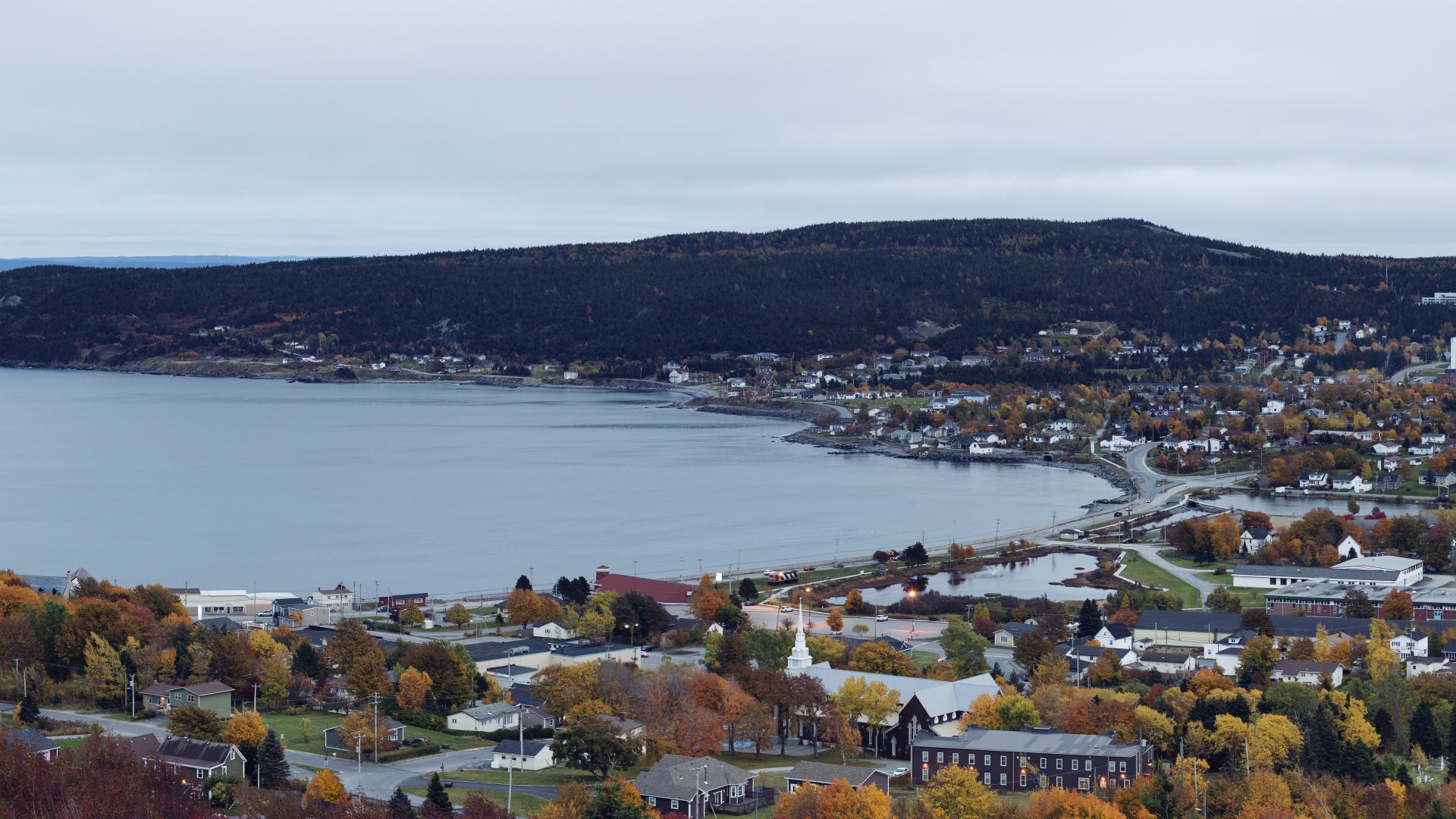
History
Welcome to our beautiful, historic town. Carbonear was first settled by people from West Country England in the early 1600’s, making it one of the oldest European settlements in North America. The town offers many attractions and amenities for tourists that reflect the town’s history and traditions.
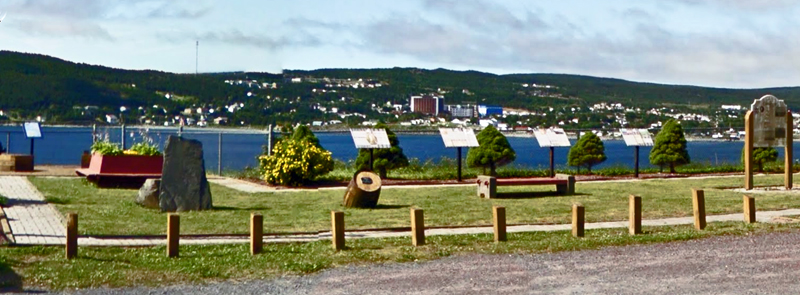
Harbour Rock Storyboards – European Settlement of Carbonear
Descendents from hardy fisher folk and merchants from the West Country of England and the Southeast of Ireland make up 95% of the town’s population. Many customs and traditions from the “old country” are still observed in Carbonear. People are very friendly and interested in telling visitors about their town, explaining about local customs, local food, and local expressions.
Music is a very important part of the cultural heritage. Newfoundland music with Celtic rhythms is widely heard and there are many local musicians who sing and play a variety of musical instruments, especially those with Irish roots. The Celtic Roots Festival takes place in July, as well as an outdoor concert in Paddy’s Garden. The Kiwanis Music Festival is held in Carbonear every spring. Talented individuals and groups of all ages from all over the Baccalieu Trail come to the Princess Sheila NaGeira Theatre to compete.

Bowman Family – Councillor Bill Bownan, (r) his sister Elaine, Neil O’Grady, and behind him Justin Bowman (Bill’s son)
History of Carbonear
One of the towns most interesting features is the large number of heritage structures that are found in all parts of the town. A number of them have been declared .Registered Heritage Structures. A few are public buildings, such as the Railway Station Museum, the old Post Office Building and the Rorke Premises; others have been made into B&Bs, and still others are private residences..
Early History
Carbonear is among the oldest settlements in North America. The harbour was named by migratory fishermen before John Guy and the other settlers arrived in Cupids in 1610, to establish the first English settlement in Canada. The settlers mention Carbonear by name in their letters and journals.
Origin of Name – Carbonear
The name Carbonear may be French or Spanish. Some people think that the name comes from a Spanish word, “carbonera”, which can mean either “wood prepared for burning into charcoal”, “charcoal kiln”, or “woman who makes or sells charcoal”. If Carbonear is a French name, it might come from the French word “Carbonnier”, which is a family name from Picardy and Normandy in France. It might also come from “La Carbonnière”, which is a place-name in Normandy.
EARLY HISTORY OF CARBONEAR
John Guy’s Colonists and Carbonear
Carbonear was named before John Guy and his colonists arrived in Cupids in 1610. The settlers mention Carbonear in their letters and journals.
In the fall of 1612, John Guy and his colonists from Cupers Cove (Cupids) sailed into Trinity Bay to find the Beothuk in order to trade with them. On November 6th, the colonists met and shared a meal with a group of Beothuk somewhere in Bull Arm. After a successful meeting with the Beothuk, their men began their return trip.
About November 14th, 1612 – on the way back to Conception Bay, the shallop (small boat) overturned near Bay de Verde. The men scrambled from the cold North Atlantic waters and made it to shore. For the next ten days, the men from the shallop walked from Bay de Verde to Carbonear. According to a letter written by one of the men, Bartholomew Pearson, the lives of the explorers were in great danger as they were faced with “great famine and much hunger”. He also stated that they were “like to be starved”. Upon arrival at Carbonear, the men found some “rotten, stinking fish” and “moulix made of mussels” . Certainly, this was not the tastiest meal they had ever eaten, but it kept them alive long enough to return home. At Carbonear, the men were also lucky enough to find an abandoned boat which they sailed back to the colony at Cupids. In 2012, a storyboard was laced on Harbour Rock Hill to commemorates the overland journey four hundred years ago of the crew of the shallop (George Wichalle, William Hadden, Bartholomew Pearson, George Frewin and Samuel Butler) They had walked the roughly 38 miles (60km) from Bay de Verde to Carbonear where they found a boat in which they sailed back to Cupids.
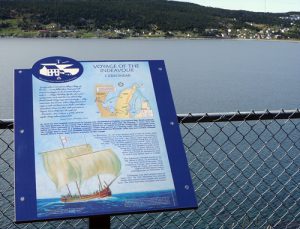
Storyboard on Harbour Rock Hill – 2012
Sir Percival Willoughby and Nicholas Guy
In the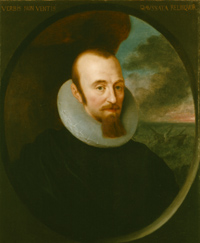 early 1600’s, much of Carbonear was part of the land granted by the English crown to Sir Percival Willoughby. Letters to and from Percival’s agents show his interest in settling the area. Several early attempts to settle the area failed.
early 1600’s, much of Carbonear was part of the land granted by the English crown to Sir Percival Willoughby. Letters to and from Percival’s agents show his interest in settling the area. Several early attempts to settle the area failed.
In a letter written to Sir Percival in 1631 , Nicholas Guy revealed that his family were settled in Carbonear and doing quite well. Nicholas asked Sir Percival to send two men to Carbonear to help since there was so much work to do. These men would have to help with the fishery and other work. Nicholas was keeping cattle and made cheese and butter from the milk. He says that he sold some of it and gave some to his neighbors.
Berry’s Census
Sir John Berry’s census of 1675, found that the Guy family was still living in Carbonear. It seems that Carbonear became a true community very early on. Cattle were raised, boats were built during the winter, the fishery was in full swing, and whole families lived there. Many women and children were living in the community while in most other Newfoundland settlements, men outnumbered the women by as much as ten to one.
William Downing and Thomas Oxford
Salt cod was an important source of food all over Europe, so controlling Newfoundland was important to both England and France. In the late 17th and early 18th centuries, England and France were fighting over Newfoundland. In 1662, the French capital of Placentia was set up in on the other side of the Avalon Peninsula in Placentia Bay, and it soon became a threat to English settlements in Conception Bay such as Carbonear. In 1679, because of this threat, William Downing and Thomas Oxford, two St. John’s merchants, said that Carbonear Island should be fortified.
King William’s War – Abbé Baudoin’s Journal
By the end of the 1600s, the disputes between England and France had become a full fledged war. Pierre Le Moyne d’Iberville, one of French Canada’s fiercest fighters let an attack on the English in Newfoundland. Accompanying him was a priest, Abbé Jean Baudoin, who kept a journal during the attack on Conception Bay in 1697. He referred to the town as Carbonnière, which suggests that the town may have been named for “La Carbonnière”, in Normandy.
Abbé Baudoin’s journal provides a great deal of information about Carbonear, showing that it was a very important town over three hundred years ago. There were 220 men, 22 planters, 50 boats, and 25 000 codfish in Carbonear. He also describes communities which are part of modern day Carbonear. He says that Croquescove (Crockers Cove) had 30 men, 4 planters, 5 boats, and 2500 codfish. Kelinscove (Clowns Cove) had 22 men, 3 planters, 4 boats, 2000 codfish. Fraische oüatre (Freshwater) had 20 men, 2 planters, 4 boats, and 2000 codfish.
He goes on to say:
“Harbour Grace has 14 planters and Carbonear 22. All of these people are very well-established. Their properties are the best-built in all of Newfoundland; however, we found nothing in them but stores of cod, oil and bread. There was no furniture. These two places supply the other English settlements with everything they need, so a lot of people from other communities come and go from those two places. There are people there with as much a £100 000 of goods, but they did not leave them here.”
Many of them had hidden their property in the woods and escaped to Carbonear Island before the French arrived.
In modern English, here is how Abbé Baudoin described what they saw on Carbonear Island as d’Iberville and his men sailed into Carbonear harbour to attack the town:
“… passing before the point of the Island of Carbonear, we saw the enemy. They were filed in large numbers and fired a few cannon shots at us. The people of Carbonear, Harbour Grace, Mosquito, other smaller harbours, and the refugees of St. John’s, have all gone to the island to get away from us. There seem to be about 200 men. They are living in barracks they had made earlier, because they were afraid that we would come…”
He went on to say:
“…if this island is as the prisoners we have taken describe, I am greatly afraid that we will not be able to capture the island. It is steep on all sides, except for a little harbour which is on the west point. That harbour is within a gunshot of a group of shallops they have put together. They have four cannons and six pounds of cannonballs. Added to this, it is only possible to unload two shallops at a time at the harbour, even when the sea is calm, and the sea is not often calm at this time of year.”
Two days later, Abbé Baudoin wrote, “We bribed a few of the prisoners and they told us there are two other places on the island where a shallop can land. From these landing places, two men climbing side by side can get to the top of the island.”
They left Carbonear and went on to attack other towns such as Bay de Verde, Old Perlican and Hant’s Harbour. They came back to Carbonear in February across the Heart’s Content Barrens, after their attacks in Trinity Bay. At that time, Abbé Baudoin said:
“We have plenty of fresh meat here; because we eat the cows from Carbonear and Harbour Grace where they were in great numbers. …These two places are situated on the northwest coast of Conception Bay, on fairly pretty little coasts.”
Carbonear Island was the only place on the Avalon Peninsula to hold out against d’Iberville’s attack. Soon d’Iberville and his men were recalled to French Canada unable to conquer the rugged little island. The war between the English and French ended for a while in 1697, so Carbonear was safe for a short time. People left the island, retrieved their belongings, and rebuilt homes and properties that had been burned burning the French raids.
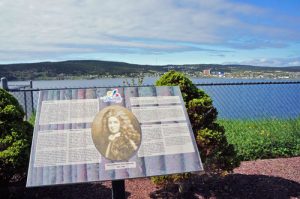
Storyboad of d’Iberville on Harbour Rock Hill
Queen Ann’s War – 1702-1713
In 1702, the English and French began fighting again, so the English and French colonists in Newfoundland knew that there would be attacks on each other’s settlements.
The settlers in Carbonear submitted petitions to Queen Anne describing what had happened during King William’s War. They stated they would go again to Carbonear Island and needed more arms from the Crown to defend themselves. They were also concerned they had to leave their property in Carbonear where the French could destroy it.
In March 1705, the French came to Carbonear and they found the settlers had moved to Carbonear Island.
William Pynne and George Davis
Over the course of the war, the residents sent a number of letters to St. John’s asking for more help, but St. John’s, which was under attack itself did not help. In 1705, William Pynne and George Davis bravely defended the area from Carbonear Island. By 1709, William Pynne was military governor of Carbonear, with his son, William, as one of his lieutenants.
End of the English / French Wars
The war between England and France ended with the signing of the Treaty of Utrecht in 1713. The British received Acadia (which they named Nova Scotia), Newfoundland and fur trading posts in the Hudson Bay area. France kept Quebec and Cape Breton Island at the northeastern end of Nova Scotia. When the war ended the citizens of Carbonear were safe from attack for a number of years. The town remained one of the most important fishing harbours in the province
Later History
In 1812 Mr. H. C. Watts asked Governor Duckworth to give Carbonear three guns to protect itself from American privateers. The biggest gun was called “Watts Long Tom” and was mounted on Harbour Rock Hill. Today two cannons can be seen on Harbour Rock Hill.
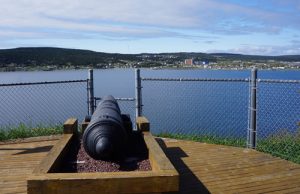
Cannon on Harbour Rock Hill
Salt Fish Trade
From the beginning of settlement in Carbonear fishing families and merchant families were involved in the salt fish trade. Fishing families caught and dried the cod in the summer and then traded it for what they needed from merchants to survive over the winter. Schooners took the dried fish to Europe, Brazil and the West Indies. There it was traded for such things as salt, molasses, coal and manufactured goods. These were resold in other ports or taken back for use by residents of Newfoundland. Residents of Carbonear in the 19th and early 20th century had to import much of what they needed from over seas by ocean going ships. This ocean trade, called “Going Foreign,” depended on strong ships which were crewed by stronger men. At that time more captains from Carbonear participated in the “Going Foreign” trade, than from any other Newfoundland outport. (Outport is the name given to any settlement in Newfoundland located on the coastline outside St. John’s.)
From the mid 1800’s right up to the beginning of World War II, Carbonear schooners and their crews took enormous risk battling stormy weather, rough seas, injury, illness and, during World War I, hostile enemy submarines. Many died, but a large number were able to return home safely. The Carbonear Heritage Society has collected stories of these heroic seafarers and artifacts related to ‘Going Foreign’ trade.

Tool Kit for Sail Repair Old Post Office Museum
In the town’s three museums, the Railway Station Museum, the Rorke Store Museum, and the Old Post Office Museum, the story of its historic contributions is told. In addition, the town offers guided walking tours in the summer during which student interpreters participate in enactments of historic events.
Map
Google Earth visited Conception Bay North in the Summer of 2014 and mapped the region, including the Town of Carbonear.
You can now view all parts of the town both on a map and as Google Street View.
If you would like a print map, please contact the town office. Tel: 709.596.3831 Email: [email protected]

